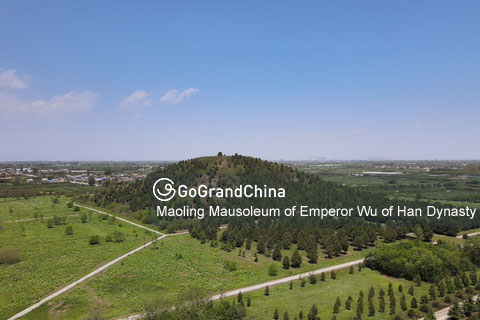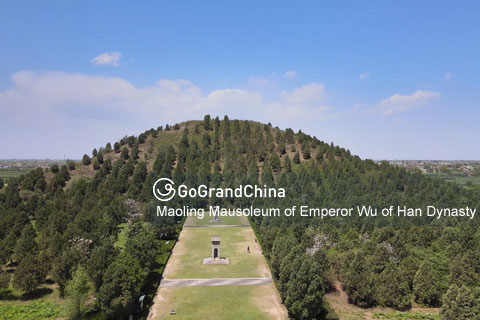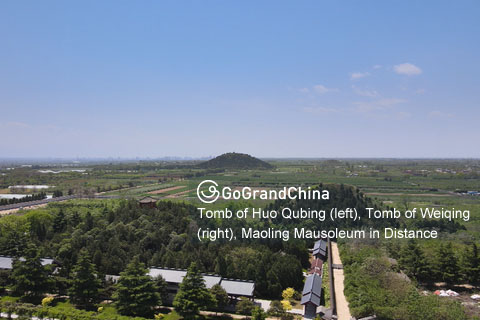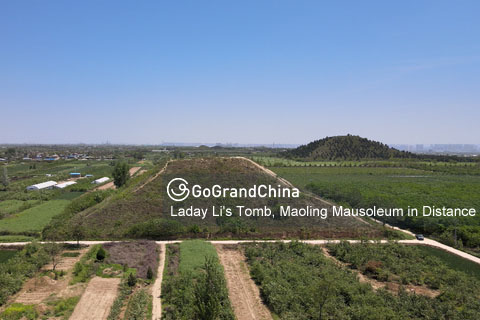You have no items in your shopping cart.
Han Maoling Mausoleum
Introducing Maoling Mausoleum of Emperor Wu of Han Dynasty
Maoling Mausoleum lies 44 km (27 mi) west of downtown Xi'an's Bell Tower. Maoling Mausoleum is a Western Han Dynasty (202 BC-8 AD) imperial tomb. Maoling Mausoleum is where Emperor Wu of Han Dynasty was buried. Emperor Wu was the 5th Han Dynasty emperor, ruling from 141 to 87 BC. His reign lasted 54 years — a record not broken until the reign of Emperor Kangxi of Qing Dynasty more than 1,800 years later. Emperor Wu is considered one of the greatest emperors in Chinese history due to his strong leadership and effective governance, which made the Han dynasty one of the most powerful nations in the world. Emperor Wu adopted Confucianism as the state philosophy and code of ethics for his empire and all later dynasties followed suit. As a military campaigner, Emperor Wu led Han China through its greatest territorial expansion. At its height, the Empire's borders spanned from the Fergana Valley in the west, to Korea in the east, and to northern Vietnam in the south. Emperor Wu dispatched his envoy Zhang Qian into the Western Regions in 139 BC to seek military alliance to fight the Huns (Xiongnu), which resulted in the opening up of the Silk Road. Emperor Wu died in 87 BC at the age of 69 and was buried at Maoling Mausoleum. Construction of Maoling Mausoleum began in 139 BC, the second year in the reign of Emperor Wu and took 53 years until completion upon the emperor's death. About one third of the court's annual revenue from taxes and tributes was used towards construction of the tomb. Standing 47 meters (154 ft) high, Maoling Mausoleum is a trapezoidal tumulus built from rammed earth with a rectangular base which measures 222 by 217 meters (728 by 712 ft). Maoling Mausoleum is the largest among the 11 imperial tombs built during the Western Han Dynasty. It is also well known as "Great White Pyramid" since U.S. Army Air Corps pilot James Gaussman saw it as "a white jewel-topped pyramid during a flight between India and China during World War Two".
Watch this video showcasing Maoling Mausoleum of Emperor Wu of Han Dynasty
Kind Notice: This video is not available in China (YouTube is blocked). If you are in China, click here.
Maoling Mausoleum of Emperor Wu of Han Dynasty Fast Facts
• Name in Chinese: Mao Ling 茂陵
• Best Time to Visit: All year round
• Recommended Visiting Hours: 2 hours
• Distance from Xian: 44 km (27 mi)
• Opening Hours: 08:00 - 18:00
• Entrance Fee: CNY75 from Mar to Nov; CNY55 from Dec to next Feb.
• Address: Maoling, Nanwei Township, Xingping County, Shaanxi Province
• Address in Chinese: 陕西省咸阳市兴平市南位镇茂陵
What to expect at Maoling Mausoleum of Emperor Wu of Han Dynasty
Maoling Mausoleum is the largest among the 11 imperial tombs built during the Western Han Dynasty. Standing 47 meters (154 ft) high, Maoling Mausoleum is a trapezoidal tumulus built from rammed earth with a rectangular base which measures 222 by 217 meters (728 by 712 ft). Besides the main tumulus mound, there are more than 20 smaller attendant tombs which belong to former members of Emperor Wu's court, such as Lady Li, the emperor's favorite concubine, and the military strategist Wei Qing and Huo Qubing. 1000 meters (3280 ft) northeast of Maoling Mausoleum, lies Huo Qubing's tomb. To praise the military achievements of Marquess of Champion Huo Qubing, Emperor Wu ordered his tomb to be constructed in the shape of Mount Qilian where Huo Qubing won many decisive battles against the Huns (Xiongnu). Various kinds of large-size carved stone animals were placed in front of and on the tomb mound of Huo Qubing, making this tomb to be the very first tomb in Chinese history to have stone sculptures of animals, among which, the “Horse Stomping Xiongnu" stone statue is the most famous one. Maoling Museum is located in Huo Qubing's tomb. The museum exhibits 4,100 cultural objects and 14 stone sculptures of animals. The golden horse of Maoling, the largest gilded horse ever found in China, was discovered in 1981 by farmers in a field nearby the mausoleum.




There are no products matching the selection.

